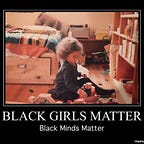Using Black People Stuff In Your Activism: A How To
Here is when you should use Black people stuff in your activism: when you are doing activism that somehow actively supports Black people. (Now scroll to the tl;dr at the bottom if you must.)
Are you Black?
If the answer is yes, then I have my own opinion about when you should and should not use Black people stuff in your activism, but I also respect that as a fellow Black person, you have an equal claim to this discourse as I do. So, for example, if you want to suggest that a white male sexual harasser and assaulter is experiencing a lynch mob akin to the primarily anti-Black ones of the American South, that is your prerogative, even if it is a garbage can comparison that pretends power dynamics and racism aren’t critical factors in the lynching story.
But what if I’m not Black?!
You should follow some rules, and you can’t just make rules up for this whenever it is convenient for you. You also should not work from an ahistorical operating principle, for example one that ignores the experiences of Black people in the Americas.
Do not:
If you want to talk about visibility of your particular marginalized group, do not start by saying, “People are so focused on Black people, but what about us?” Black people have fought for every single ounce of recognition they have. Black Americans have literally fought for the right to be counted as whole people in the U.S. Constitution. Your beef is not with Black people. It is with the people who have been screwing Black people and your particular group and especially people who may be both Black and members of your group.
You also should not compare your experience or history of marginalization with Black experiences and histories. No, you weren’t written into the U.S. Constitution as 3/5ths of a human being, so stop it. The historical context is not the same. Stop it. It offends me as someone who has a relationship with facts and as a Black person when people do this. And it goes both ways: the way that ableism is built into the American fabric is different from the way racism is built in, for example. You can’t properly confront both without being honest about those differences.
Do:
So, here is when you can use Black people stuff in your discourse about your own marginalized group that is not necessarily composed of Black people: when it is to uplift the members of your group who are also Black.
They exist!
There are Black Native Americans. There are Black people with disabilities. There are Black Asian Americans. There are Black Native Americans with disabilities. There are Black Native Americans who have experienced anti-Black racism in the Native community. There are Black Americans with disabilities who feel invisible in the disability activism community. There are Black Asian Americans who feel invisible in the Asian American activism community. Gay rights are not “the new Civil Rights movement.” The Civil Rights Movement is still the Civil Rights Movement, but expanding it to explicitly include, love and support Black gay/trans/queer people is new. And so on.
Do read Scot Nakagawa’s piece Blackness is the Fulcrum:
The racial arrangement in the U.S. is ever changing. There is no “bottom.” Different groups have more ability to affect others at different times because our roles are not fixed. But, while there’s no bottom, there is something like a binary in that white people exist on one side of these dynamics — the side with force and intention. The way they mostly assert that force and intention is through the fulcrum of anti-black racism.
While I continue to think that Scot should have spent more time unpacking this in relation to the disposession and genocide of Native peoples, I think he makes an important point.
Do be intersectional in your approach. If you want an example of how to be truly intersectional while also focusing on one particular marginalization experience, check out Autistic Hoya.
Here is a talk where I give various definitions of intersectionality and also focus heavily on indigenous issues (albeit imperfectly, something I am trying to fix in my written adaptation of the speech) while not using Black people stuff to do it:
Do understand the limits of identity politics. Just because someone is Black doesn’t mean everything they say about Black people resonates with most Black people or is helpful to Black people. (See my lynch mob example above.) Patriarchy, anti-Blackness, anti-Indigeneity, ableism, transphobia, etc: these do not have a color line, a gender line, an ethnicity line, or a disability status line. We are all capable of being co-opted.
tl;dr: you can use Black people stuff in your activism when you are explicitly doing work to benefit some or all Black people. This means, you have to mention Black people. Not substitutes like “minorities” or “diversity.” I don’t want to hear no bullshit about, “Well since there are Black members of my community, it’s implicit.” Sorry, we don’t live in that world. Explicit or not at all. And of course this is generally true with any marginalized groups: don’t use people with different marginalizations from you to build your movement. You’re only serving oppression when you do.
